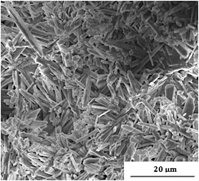Crossref Citations
This article has been cited by the following publications. This list is generated based on data provided by
Crossref.
Gurgul, Sebastian J.
Seng, Gabriel
and
Williams, Gareth R.
2019.
A kinetic and mechanistic study into the transformation of calcium sulfate hemihydrate to dihydrate.
Journal of Synchrotron Radiation,
Vol. 26,
Issue. 3,
p.
774.
Krejsová, J
Schneiderová Heralová, R
Doleželová, M
and
Vimmrová, A
2019.
Environmentally friendly lightweight gypsum-based materials with waste stone dust.
Proceedings of the Institution of Mechanical Engineers, Part L: Journal of Materials: Design and Applications,
Vol. 233,
Issue. 3,
p.
258.
Tao, Yuan
Zhang, Wei
and
Wang, Feng-shou
2020.
Development of a Gypsum Foaming Agent Based on Alkyl Polyglucosides.
Tenside Surfactants Detergents,
Vol. 57,
Issue. 5,
p.
408.
Ranachowski, Zbigniew
Ranachowski, Przemysław
Dębowski, Tomasz
Brodecki, Adam
Kopec, Mateusz
Roskosz, Maciej
Fryczowski, Krzysztof
Szymków, Mateusz
Krawczyk, Ewa
and
Schabowicz, Krzysztof
2020.
Mechanical and Non-Destructive Testing of Plasterboards Subjected to a Hydration Process.
Materials,
Vol. 13,
Issue. 10,
p.
2405.
Arroyo, F.N.
Christoforo, A.L.
Salvini, V.R.
Pelissari, P.I.B.G.B.
Pandolfelli, V.C.
Luz, A.P.
and
Cardoso, C.A.
2020.
Development of plaster foam for thermal and acoustic applications.
Construction and Building Materials,
Vol. 262,
Issue. ,
p.
120800.
Lukuttsova, N. P.
Pykin, A. A.
Golovin, S. N.
and
Artamonova, E. G.
2021.
Innovations and Technologies in Construction.
Vol. 95,
Issue. ,
p.
313.
de Souza Conceição, Lucas
de Vasconcelos Ferraz, Andréa
Pereira Ramos, Rodrigo
Bárbara de Souza Silva, Yasmin
and
dos Santos Costa, Daniel
2021.
Application of bromocresol purple dye for plaster drying time determination.
Construction and Building Materials,
Vol. 278,
Issue. ,
p.
122378.
Gao, Kefeng
Wang, Faheng
Zhang, Mingyang
Zhang, Jian
Jiao, Da
Xu, Qian
Guan, Jianjun
Zhang, Xing
Liu, Zengqian
and
Zhang, Zhefeng
2021.
High-strength and multi-functional gypsum with unidirectionally porous architecture mimicking wood.
Chemical Engineering Journal Advances,
Vol. 7,
Issue. ,
p.
100114.
Kasyap, Sathwik S.
and
Senetakis, Kostas
2021.
Application of Nanoindentation in the Characterization of a Porous Material with a Clastic Texture.
Materials,
Vol. 14,
Issue. 16,
p.
4579.
Zong, Zhifang
Chen, Depeng
Zhao, Chunxiao
Tang, Gang
Ji, Yilong
Zhang, Hao
and
Lv, Zhong
2021.
Application of Ce–Eu/TiO2 phase change material as the wall material to improve the indoor environment.
Journal of Materials Research,
Vol. 36,
Issue. 3,
p.
615.
Herrero, Juan
and
Zartman, Richard E.
2021.
Established soil science methods can benefit the construction industry when determining gypsum content.
Cleaner Engineering and Technology,
Vol. 4,
Issue. ,
p.
100154.
Trosseille, Joachim
Panczer, Gérard
Martinet, Christine
and
Le Merrer, Marie
2022.
Monitoring Gypsum Plaster Setting in a Foam through Raman Spectroscopy.
Physical Review Applied,
Vol. 18,
Issue. 3,
Meng, Xinyu
Zhou, Pingping
Hu, Xueyi
Liu, Jianyi
and
Xia, Yongmei
2023.
Influence of polysulfonates on the properties of β-calcium sulfate hemihydrate and its hydration.
Journal of Dispersion Science and Technology,
Vol. 44,
Issue. 3,
p.
449.
Liu, Junchao
Xie, Hui
Wang, Chong
and
Han, Yue
2023.
Preparation of multifunctional gypsum composite with compound foaming process.
Powder Technology,
Vol. 418,
Issue. ,
p.
118289.
Bumanis, Girts
Vitola, Laura
Zhou, Xiangming
Vaičiukynienė, Danutė
and
Bajare, Diana
2024.
Towards 3D Pore Structure of Porous Gypsum Cement Pozzolan Ternary Binder by Micro-Computed Tomography.
Journal of Composites Science,
Vol. 8,
Issue. 7,
p.
264.
Yu, Jian
Wang, Hongxia
Wu, Fade
Yu, Haiyan
and
Guo, Junhua
2024.
Effects of Water-Reducing Agents on the Mechanical Properties of Foamed Phosphogypsum.
Applied Sciences,
Vol. 14,
Issue. 18,
p.
8147.
Liu, Junchao
Xie, Hui
Wang, Chong
and
Li, Bo
2025.
Evaluation of pore structure, mechanical properties, and sound absorption of composite foamed gypsum.
Construction and Building Materials,
Vol. 472,
Issue. ,
p.
140852.




